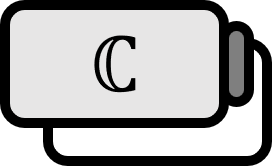Types of Singularities in Complex Analysis
Definitions
Singularity 1
- If the function $f$ is differentiable at all points of $\mathcal{N}(\alpha)$ in $\alpha$, it is said to be analytic at $\alpha$.
- If the function $f$ is not analytic in $\alpha \in \mathbb{C}$ but is analytic at some points of $\mathcal{N}(\alpha)$, $\alpha$ is called a Singular Point of $f$.
- If there exists $\mathcal{N}(\alpha)$ that is analytic at all points except for $\alpha$, then $\alpha$ is said to be isolated.
- $\mathcal{N}$ denotes a neighborhood, meaning an open set that includes $\alpha$.
Types
Let’s say $\alpha \in \mathbb{C}$ is a singular point of $f$.
- $\displaystyle \exists \lim_{z \to \alpha} f(z) \iff$ $\alpha$ is a removable singularity.
- $\displaystyle \lim_{z \to \alpha} (z - \alpha)^n f(z) = k \ne 0 \iff$ $\alpha$ is a Pole of Order $n$.
- If $\alpha$ is not a pole or is associated with a branch, $\iff$ $\alpha$ is an essential singular point.
Description
Particularly, a pole is a Simple Pole if it is $n=1$.
In fact, unless it is a very perverted case, the points where $f$ is undefined usually become singularities.
For example, if it were said that $\displaystyle f(z) = {{z - i} \over {(z^2+1)(z+i)}}$, then the singularity would be $z= \pm i$. It’s not necessarily finite, as in the case of $\csc z$ where $z = n \pi ( n \in \mathbb{Z} )$ are all singularities. On the other hand, $\text{Log} z$ has a singularity at $z= 0$, which might feel a bit different from the examples mentioned above.
In $\displaystyle f(z) = {{z - i} \over {(z^2+1)(z+i)}}$, $z = i$ is removable, and $z = -i$ is a pole of order $2$.
Since $\displaystyle \lim_{z \to n \pi} {{ z - n \pi } \over {\sin z }} = 1$, the singularities of $\csc z$ are all poles of order $1$, namely simple poles.
Lastly, in $\text{Log} z$, $z = 0$ is a branch point, thus, an essential singularity.
The classification of such singularities might seem at first glance like a meaningless play on definitions, but it becomes a very important concept in the subsequent discussions on integrals.
Osborne (1999). Complex variables and their applications: p63. ↩︎
